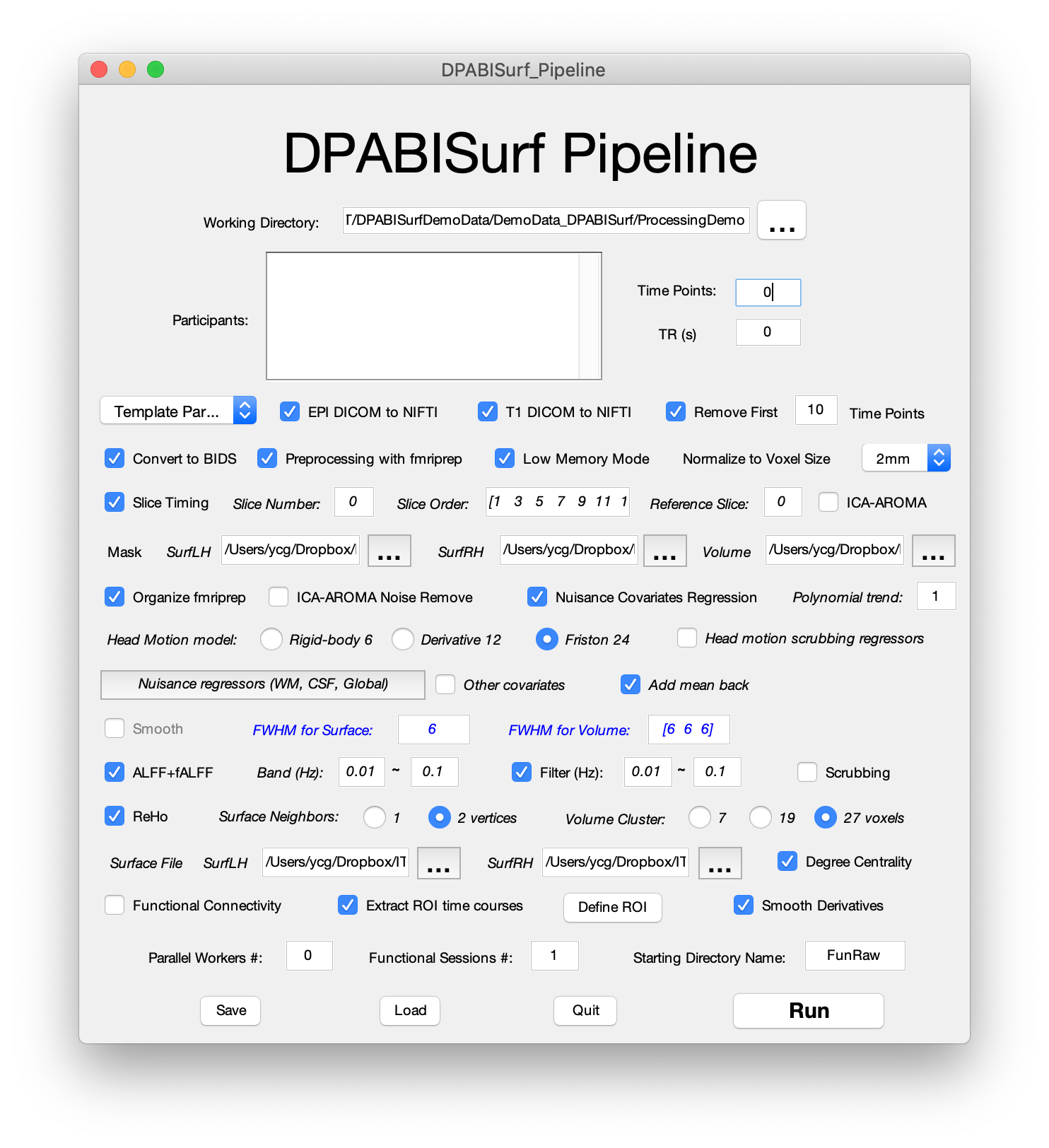Dear Colleagues,
We are pleased to announce the release of DPABISurf V1.1!
DPABISurf is a surface-based resting-state fMRI data analysis toolbox evolved from DPABI/DPARSF, as easy-to-use as DPABI/DPARSF. DPABISurf is based on fMRIPprep 1.4.1 (Esteban et al., 2018)(RRID:SCR_016216), and based on FreeSurfer 6.0.1 (Dale et al., 1999)(RRID:SCR_001847), ANTs 2.2.0 (Avants et al., 2008)(RRID:SCR_004757), FSL 5.0.9 (Jenkinson et al., 2002)(RRID:SCR_002823), AFNI 20160207 (Cox, 1996)(RRID:SCR_005927), SPM12 (Ashburner, 2012)(RRID:SCR_007037), PALM alpha112 (Winkler et al., 2016), GNU Parallel (Tange, 2011), MATLAB (The MathWorks Inc., Natick, MA, US) (RRID:SCR_001622), Docker (https://docker.com) (RRID:SCR_016445), and DPABI V4.1 (Yan et al., 2016)(RRID:SCR_010501). DPABISurf provides user-friendly graphical user interface (GUI) for pipeline surface-based preprocessing, statistical analyses and results viewing, while requires no programming/scripting skills from the users.
The DPABISurf pipeline first converts the user specified data into BIDS format (Gorgolewski et al., 2016), and then calls fMRIPprep 1.4.1 docker to preprocess the structural and functional MRI data, which integrates FreeSurfer, ANTs, FSL and AFNI. With fMRIPprep, the data is processed into FreeSurfer fsaverage5 surface space and MNI volume space. DPABISurf further performs nuisance covariates regression (including ICA-AROMA) on the surface-based data (volume-based data is processed as well), and then calculate the commonly used R-fMRI metrics: amplitude of low frequency fluctuation (ALFF) (Zang et al., 2007), fractional ALFF (Zou et al., 2008), regional homogeneity (Zang et al., 2004), degree centrality (Zuo and Xing, 2014), and seed-based functional connectivity. DPABISurf also performs surface-based smoothing by calling FreeSurfer’s mri_surf2surf command. These processed metrics then enters surfaced-based statistical analyses within DPABISurf, which could perform surfaced-based permutation test with TFCE by integrating PALM. Finally, the corrected results could be viewed by the convenient surface viewer DPABISurf_VIEW, which is derived from spm_mesh_render.m.
DPABISurf is designed to make surface-based data analysis require minimum manual operations and almost no programming/scripting experience. We anticipate this open-source toolbox will assist novices and expert users alike and continue to support advancing R-fMRI methodology and its application to clinical translational studies.
DPABISurf is open-source and distributed under GNU/GPL, available with DPABI at http://www.rfmri.org/dpabi. It supports Windows 10 Pro, MacOS and Linux operating systems. You can run it with or without MATLAB.
1. With MATLAB.
1.1. Please go to http://www.rfmri.org/dpabi to download DPABI.
1.2. Add with subfolders for DPABI in MATLAB's path setting.
1.3. Input 'dpabi' and then follow the instructions of the "Install" Button on DPABISurf.
2. Without MATLAB.
2.1. Install Docker.
2.2. Terminal: docker pull cgyan/dpabi
2.3. Terminal: docker run -d --rm -v /My/FreeSurferLicense/Path/license.txt:/opt/freesurfer/license.txt -v /My/Data/Path:/data -p 5925:5925 cgyan/dpabi x11vnc -forever -shared -usepw -create -rfbport 5925
/My/FreeSurferLicense/Path/license.txt: Where you stored the FreeSurferLicense got from https://surfer.nmr.mgh.harvard.edu/registration.html.
/My/Data/Path: This is where you stored your data. In Docker, the path is /data.
2.4. Open VNC Viewer, connect to localhost:5925, the password is 'dpabi'.
2.5. In the terminal within the VNC Viewer, input "bash", and then input:
/opt/DPABI/DPABI_StandAlone/run_DPABI_StandAlone.sh ${MCRPath}
Now please enjoy the StandAlone version of DPABISurf with GUI!
If you don't want to run with GUI, you can also call the compiled version of DPABISurf_run. E.g.,
docker run -it --rm -v /My/FreeSurferLicense/Path/license.txt:/opt/freesurfer/license.txt -v /My/Data/Path:/data cgyan/dpabi /bin/bash
/opt/DPABI/DPABI_StandAlone/run_DPABISurf_run_StandAlone.sh ${MCRPath} /data/DPABISurf_Cfg.mat
References:
- Ashburner, J. (2012). SPM: a history. Neuroimage, 62(2), 791-800, doi:10.1016/j.neuroimage.2011.10.025.
- Avants, B.B., Epstein, C.L., Grossman, M., Gee, J.C. (2008). Symmetric diffeomorphic image registration with cross-correlation: evaluating automated labeling of elderly and neurodegenerative brain. Med Image Anal, 12(1), 26-41, doi:10.1016/j.media.2007.06.004.
- Cox, R.W. (1996). AFNI: software for analysis and visualization of functional magnetic resonance neuroimages. Comput Biomed Res, 29(3), 162-173.
- Dale, A.M., Fischl, B., Sereno, M.I. (1999). Cortical surface-based analysis. I. Segmentation and surface reconstruction. Neuroimage, 9(2), 179-194, doi:10.1006/nimg.1998.0395.
- Esteban, O., Markiewicz, C.J., Blair, R.W., Moodie, C.A., Isik, A.I., Erramuzpe, A., Kent, J.D., Goncalves, M., DuPre, E., Snyder, M., Oya, H., Ghosh, S.S., Wright, J., Durnez, J., Poldrack, R.A., Gorgolewski, K.J. (2018). fMRIPrep: a robust preprocessing pipeline for functional MRI. Nat Methods, doi:10.1038/s41592-018-0235-4.
- Gorgolewski, K.J., Auer, T., Calhoun, V.D., Craddock, R.C., Das, S., Duff, E.P., Flandin, G., Ghosh, S.S., Glatard, T., Halchenko, Y.O., Handwerker, D.A., Hanke, M., Keator, D., Li, X., Michael, Z., Maumet, C., Nichols, B.N., Nichols, T.E., Pellman, J., Poline, J.B., Rokem, A., Schaefer, G., Sochat, V., Triplett, W., Turner, J.A., Varoquaux, G., Poldrack, R.A. (2016). The brain imaging data structure, a format for organizing and describing outputs of neuroimaging experiments. Sci Data, 3, 160044, doi:10.1038/sdata.2016.44.
- Jenkinson, M., Bannister, P., Brady, M., Smith, S. (2002). Improved optimization for the robust and accurate linear registration and motion correction of brain images. Neuroimage, 17(2), 825-841.
- Tange, O. (2011). Gnu parallel-the command-line power tool. The USENIX Magazine, 36(1), 42-47.
- Winkler, A.M., Ridgway, G.R., Douaud, G., Nichols, T.E., Smith, S.M. (2016). Faster permutation inference in brain imaging. Neuroimage, 141, 502-516, doi:10.1016/j.neuroimage.2016.05.068.
- Yan, C.G., Wang, X.D., Zuo, X.N., Zang, Y.F. (2016). DPABI: Data Processing & Analysis for (Resting-State) Brain Imaging. Neuroinformatics, 14(3), 339-351, doi:10.1007/s12021-016-9299-4.
- Zang, Y., Jiang, T., Lu, Y., He, Y., Tian, L. (2004). Regional homogeneity approach to fMRI data analysis. Neuroimage, 22(1), 394-400, doi:http://dx.doi.org/10.1016/j.neuroimage.2003.12.030.
- Zang, Y.F., He, Y., Zhu, C.Z., Cao, Q.J., Sui, M.Q., Liang, M., Tian, L.X., Jiang, T.Z., Wang, Y.F. (2007). Altered baseline brain activity in children with ADHD revealed by resting-state functional MRI. Brain Dev, 29(2), 83-91, doi:10.1016/j.braindev.2006.07.002.
- Zou, Q.-H., Zhu, C.-Z., Yang, Y., Zuo, X.-N., Long, X.-Y., Cao, Q.-J., Wang, Y.-F., Zang, Y.-F. (2008). An improved approach to detection of amplitude of low-frequency fluctuation (ALFF) for resting-state fMRI: Fractional ALFF. Journal of Neuroscience Methods, 172(1), 137-141, doi:http://dx.doi.org/10.1016/j.jneumeth.2008.04.012.
- Zuo, X.-N., Xing, X.-X. (2014). Test-retest reliabilities of resting-state FMRI measurements in human brain functional connectomics: A systems neuroscience perspective. Neuroscience & Biobehavioral Reviews, 45, 100-118, doi:http://dx.doi.org/10.1016/j.neubiorev.2014.05.009.
--
Institute of Psychology, Chinese Academy of Sciences
16 Lincui Road, Chaoyang District, Beijing 100101, China


